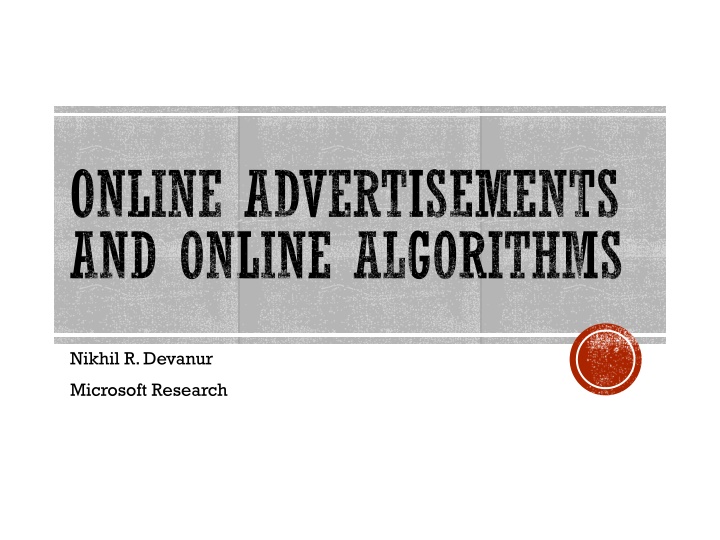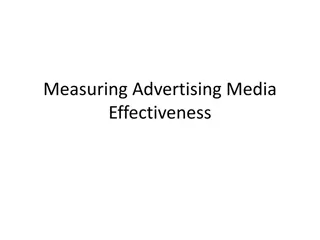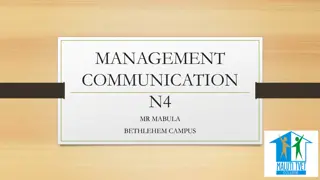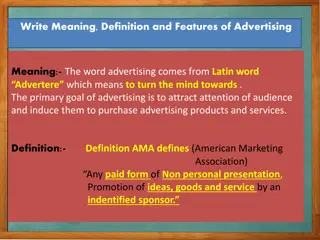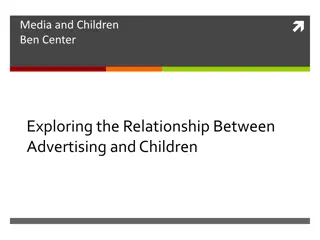Online Advertising and Algorithms: Insights and Simplifications
Explore the world of online advertisements and algorithms through insightful discussions on online advertising, modern developments in online algorithms, and practical optimization strategies like budgeted allocation. Delve into topics such as decision-making under uncertainty, accessing algorithms, caching, load balancing, and more. Discover how online algorithms have evolved to simplify complex processes like budget allocation without game theory involvement, providing practical solutions for advertisers.
Download Presentation

Please find below an Image/Link to download the presentation.
The content on the website is provided AS IS for your information and personal use only. It may not be sold, licensed, or shared on other websites without obtaining consent from the author.If you encounter any issues during the download, it is possible that the publisher has removed the file from their server.
You are allowed to download the files provided on this website for personal or commercial use, subject to the condition that they are used lawfully. All files are the property of their respective owners.
The content on the website is provided AS IS for your information and personal use only. It may not be sold, licensed, or shared on other websites without obtaining consent from the author.
E N D
Presentation Transcript
ONLINE ADVERTISEMENTS AND ONLINE ALGORITHMS Nikhil R. Devanur Microsoft Research
ONLINE ALGORITHMS List accessing, Caching, k-server, load balancing, call admission, circuit routing, . Decision making under uncertainty Modern developments 1998
Big Simplification!!! No game theory Purely optimization 1. ADWORDS. MEHTA, SABERI, VAZIRANI, VAZIRANI, 2005. AKA ONLINE BUDGETED ALLOCATION ? 2 1 ? . . . . . . Queries (?) ??? . . . Advertisers (?) . . . ? 2 1 ? Spend ?? Objective: Maximize ?min ?:? ????,?? Greedy Algorithm: of optimum
1. ADWORDS. MEHTA, SABERI, VAZIRANI, VAZIRANI, 2005. AKA ONLINE BUDGETED ALLOCATION Balance Algorithm Allocation rule: ? argmax ? ? ???1 ?? a ??= ? Unspent fraction of budget of ? Worst-case performance guarantee Competitive Ratio = 1 1 Bid to budget ratio is small 1 ? (1 ?) ? (tight)
2. PRIMAL-DUAL. BUCHBINDER, JAIN, NAOR, 2005. LP relaxation: Dual LP : max ?????? ??? ???? + ?? ?,? ? ? ? ??????? ?? ? ???? ?,? ??? ?,??????+ ?? ??? ?,? ??,?? 1 0 0 Fix ?, ?, ?? ???1 ?? ?? max ???(1 ??) ? Complementary slackness condition: ???> 0 ??= ???(1 ??) Same allocation rule: ? argmax ???1 ?? a
3. STOCHASTIC MODEL. D, HAYES, 2009. Input comes from some distribution, unknown to the algorithm. Worst case over all distributions in some class. IID Random order Use dual based alloc. Training: learn duals ?? 1 ? ? Competitive Ratio 1 as bid/budget 0 CR = 1 ? if bid/budget ? ?3 ? log ?
3. STOCHASTIC MODEL. D, HAYES, 2009. Agrawal, Wang, Ye, 2010 Repeat as #samples doubles ?2 CR = 1 ? if bid/budget ? ? log ? ?? Agrawal, Wang, Ye & Feldman, Henzinger, Korula, Mirrokni, Stein, 2010 Generalized to a wide class of Packing problems.
DISPLAY ADS OPTIMIZATION AKA ONLINE WEIGHTED MATCHING ? 2 1 ? . . . . . . Impressions (?) ??? . . . Advertisers (?) . . . ? 2 1 ? Capacity ?? Objective: Maximize ?,?:? ? ??? Very close to the actual problem: guaranteed delivery Dual based allocation: ? argmax ??? ??: put in practice
4. CONTINUOUS LEARNING. D, JAIN, SIVAN, WILKENS, 2011. Continuously update duals Converge faster Adapt to changes Not reactive enough Solving big LPs is not fast Distribution not stationary For ? = 1..?, ??????? ?? 1 ??? + 1 = ??? exp ? ? ?2 Optimal convergence rate: 1 ? CR when bid/budget log ?
4. CONTINUOUS LEARNING. D, JAIN, SIVAN, WILKENS, 2011. Adversarial Stochastic Input (ASI) Each time step a different distribution ?? ?? unknown to the algorithm Either ???(??) is always high, or know ???= exp. rate of consumption: learnt from historic data Special case: I.I.D with unknown distributions: ??= ? Used at Microsoft Simple too!
5. NO-REGRET LEARNING. AGRAWAL, D, 2015. Conjectured connection to experts problem aka no-regret learning in MSVV, 2007. ?, pick 1 out of ? experts, then see rewards of all experts No-regret: reward of algo reward of best expert - ?log? Normalization ??s probabilities Online BA Experts ??? ?? ?? ? ? ??? rewards = ? ?.?.
5. NO-REGRET LEARNING. AGRAWAL, D, 2015. More Desiderata Non-linear penalties for ``under-delivery" Advertisers require a mixture of different impression types Multiple types of value objective -- revenue, relevance, clicks, conversions, etc. Can be modeled as concave objective function/convex constraints
GENERALIZATIONS Combinatorial constraints: multiple ads on page Kapralov, Post, Vondrak, 2013 D, Huang, Korula, Mirrokni, Yan, 2013 Korula, Mirrokni, Zadimoghaddam, 2015 Mixing worst case + stochastic Mahdian, Nazerzadeh, Saberi, 2007 Mirrokni, OviesGharan, ZadiMoghaddam, 2012 Efsindiari, Korula, Mirrokni, 2015 Multiple objectives: Revenue, relevance, etc. Korula, Mirrokni, Zadimoghaddam, 2013
FLUID MEAN FIELD EQUILIBRIA BALSEIRO, BESBES, WEINTRAUB, 2013. Display Ad Exchanges: Each impression is sold via a 2nd price auction Maximum competing bid: ?? max ? ? ?? ?? Bid landscape ?,?? Bid functions ??:? bid Best-response: max utility, s.t. budget in exp. Optimal stategy: ??? = 1 ??? Bid lowering in search ad auctions: Karande, Mehta, Srikant 2013
THROTTLING IN SEARCH ADS. CHAKRABARTY, CHARLES, CHICKERING, D, WANG, 2013. Selectively participate in GSP auctions Don t change bids All competing bids Thresholds Bid landscape ?,?? ??: participate iff ROI = ??/?? ?? Best-response: max utility, s.t. budget. Given ?? ?, find ad slate satisfying ROI conditions Equilibrium Exists + Heuristics to converge to
ONLINE MECHANISM DESIGN Design auction for repeated allocation Advertisers present at start, submit all bids Supply uncertain Allocations online, payment online/at the end Single item, multiple copies, unknown number of copies Babaioff, Blumrosen, Roth, 2009 maximize welfare, prompt payments, ?(log?) vs. (loglog?) approx D, Hartline, 2009 revenue, payments at the end, ?(1) approx Goel, Paes Leme, Mirrokni, 2013 Budget constraints, Pareto optimal
ONLINE MECHANISM DESIGN 2 items 2 bidders, Item 1 arrives first Item 2 may or may not arrive Payment at the end. Maximize welfare Worst Case Approximation by Truthful Auctions? Always allocate both items No truthful mechanism D, Syrgkanis, Sivan 2015 * Deterministic Mechanisms
SUMMARY Non game theoretic, online allocation problem Highest discounted value Dual based allocation Continuous learning dual updating algorithms, designed for suitable stochastic models, work well in practice Game theory + online allocation Fix auction format + Equilibrium of this game Bid lowering vs. throttling Impossible to be truthful even in very simple settings Truthful + asymptotically optimal in a suitable stochastic setting?
